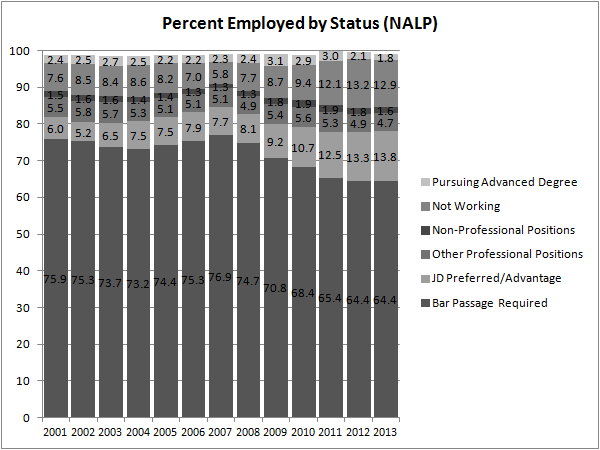…Pretty much sums up my response to the National Association for Law Placement’s analysis of the class of 2013’s employment outcomes.
Quoth Executive Director James Leipold:
As the legal services market continues to change at a rapid pace following the dramatic downsizing during the recession, the variety and diversity of jobs that law grads take now is greater than ever. In general, the picture that emerges is one of slow growth, and growth that is a blend of continued shrinkage and downsizing in some areas offset by growth in other areas.
Although the NALP changed its terminology from “JD Preferred” to “JD Advantage” starting with the class of 2011, this year marks the record percentage of JD Advantage jobs.
The good news is that the percent not working (aka the unemployment rate) has fallen to 12.9 percent. The record was 14.6 percent in 1993. I’m confident that record will not be breached, so there’s some good news. Indeed, I think it’s disturbing that the early ’90s recession mauled law practice so badly.
As for the JD Advantageers (seriously, slap a jetpack on them and shoot them into the sky), though, I did a quick correlation analysis for the 2001-2013 period. JD Advantage has a surprising -0.94 correlation with Bar Passage Required and an unfortunate 0.85 correlation with Not Working. This bodes ill for the merits of JD Advantage generally.
As for the correlation between JD Advantage and employer types, again, private practice correlates at -0.94. (Wow.) Business and Industry weighs in at 0.97, but Public Interest comes in at 0.91, which is either good or means that Public Interest has been watered down with people who couldn’t find work in firms.
(I forgot to mention that Business and Industry hit a record 18.4 percent of employer types this year.)
So yeah, strong positive correlations with unemployment is usually something you don’t want when making sense of employment categories. Thus, when Leipold says that the picture is one of “slow growth that is a blend of continued shrinkage and downsizing in some areas offset by growth in other areas,” I caution against seeing growing proportions of JD Advantage outcomes as plausibly representing a positive future for law school graduates.
Leipold, lamentably, disagrees:
It is not true that there are too many lawyers — indeed even today most Americans do not have adequate access to affordable legal services — but the traditional market for large numbers of law graduates by large law firms seeking equity-track new associates is not likely to ever return to what it was in 2006 or 2007, and thus aggregate earning opportunities for the class as a whole are not likely to return to what they were before the recession.
Not too many lawyers? Tell that to the JD Advantage cadre.

“Thus, when Leipold says that the picture is one of “slow growth that is a blend of continued shrinkage and downsizing in some areas offset by growth in other areas,””
How folks in the legal education/profession can use the term “growth” at any level when describing the legal labor market should be prohibited from ever speaking/writing on the subject. Bar passage rates, as reported by NALP, have trended downward from the 1980s peak of 84.5%, down to in the 70s in the mid-2000s, and now at 64.4%. The market. Is. Not. Growing.
Also, this is ridiculous:
“It is not true that there are too many lawyers — indeed even today most Americans do not have adequate access to affordable legal services — but the traditional market for large numbers of law graduates by large law firms seeking equity-track new associates is not likely to ever return to what it was in 2006 or 2007, and thus aggregate earning opportunities for the class as a whole are not likely to return to what they were before the recession.”
Well, the % of grads working in law firms is increasing for large firms (101 or more), and decreasing in all other size firms (except for 2-10, which has remained relatively constant save for the rise during the mid-1990s). So, if grads can’t turn to large firms, where are they going to go?
Hey, the Employment Situation says the legal sector added 1,200 jobs this month, 5,400 since last June. That’s four law schools worth of graduates since May! All hail the JD premium!
The ABA should anoint, I mean accredit, a dozen more law schools with those numbers.
Quoth Dean of Any College, circa 1932: ‘As the goes to h*ll, the variety and diversity of jobs that grads take now is greater than ever. ‘
I’ll bet that that was true; far more grads were working in ‘whatever, and glad to have it’ in 1932 than in 1928.
“It is not true that there are too many lawyers — indeed even today most Americans do not have adequate access to affordable legal services — ”
Because they can’t pay for it. OTOH, law schools and the student loan agencies will make *you* pay.
“…but the traditional market for large numbers of law graduates by large law firms seeking equity-track new associates is not likely to ever return to what it was in 2006 or 2007, and thus aggregate earning opportunities for the class as a whole are not likely to return to what they were before the recession.”
Meaning that the number of jobs which pay enough to justify law school debt are shrinking.